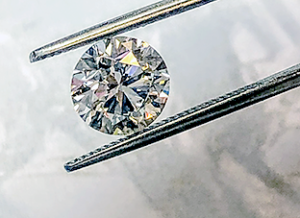
You might think that the gemstone in the middle of your ring, earrings, or even your necklace is extremely hard and sturdy. However, some gemstones are harder than others. The chances are that you will find harder stones than the ones on your jewelry items. It is no wonder that over time, your jewelry starts to fade, look rotten, or the color starts to become unappealing.
The diamond is known to be the hardest gemstone, while talc is a soft mineral. The Mohs Hardness Scale is used to determine the hardness of gemstones. What this scale does is that it compares how resistant a mineral is by scratching it with ten different reference minerals of different levels of hardness.
For instance, if Mineral B has successfully scratched Mineral A, it goes to show that Mineral A is not as strong and hard as Mineral B. A stone is put on the Mohs Hardness Scale as it finds its way up by being compared to the reference minerals.
The Mohs Hardness Scale – What is it?

The Mohs Hardness Scale came into existence in 1812 and was made by Friedrich Mohs, a German mineralogist. The bigger mineralogy community started to use the scale by 1820. There were ten different minerals of different levels of hardness on the Mohs scale.
- Talc
- Gypsum
- Calcite
- Fluorite
- Apatite
- Feldspar
- Quartz
- Topaz
- Corundum
- Diamond
These minerals were used as reference stones against which the hardness of other stones could be calculated.
Knowing How Hard a Gemstone is – Why is it Important?
It is important to understand where your gemstone lies on the Mohs Hardness Scale, and this helps jewelers understand the kind of stone that will complement a certain jewelry piece best. For instance, even today, engagement rings are extremely popular. They are usually worn every single day, which means that they go through some rough conditions.
If the stone in these engagement rings was not hard, it would rot or break over time. If a gemstone falls below seven on the Mohs Hardness Scale, it is considered to be unworthy of being used for an engagement ring.
Moreover, knowing how hard a gemstone is helps you understand how to care for the piece of jewelry and what to keep it away from. For example, a topaz is weaker than a diamond. This means that both of them should not be kept together; otherwise, the diamond may damage the topaz.
Alternative Measures of Hardness
There is another method of measuring gemstone hardness other than the Mohs Scale. This is known as the Vickers Hardness Scale which is used to measure the kind of indent made in a stone by a special diamond. The Vickers Scale can portray a clearer difference in hardness between two gems, while the Mohs Scale is not as linear.
For instance, according to the Vickers Scale, diamonds are 300 percent harder than corundum. This falls from 9 to 10 on the Mohs Scale. Moreover, it shows that calcite is 25 percent harder than fluorite, falling from 3 to 4 on the Mohs Scale. This goes to show that the Vickers Scale is a lot more accurate, and provides detailed, reliable information.
Is Gemstone Toughness the Same Thing as Gemstone Hardness?

The hardness of a gemstone is determined by how well it can withstand being scratched. On the other hand, the toughness of a gemstone depends on whether it can resist fracture if force and pressure are applied and how well it can resist that fracture. Stones of the same family may have varying levels of toughness based on the inclusions and residual stresses that show up because of heating and cutting processes.
Gemstone durability, also known as wearability, is important to understand. For example, an opal that has a hardness of 6 will be more vulnerable to fine scratches and loss of polish if it is worn as regularly as a ringstone. Quartz has a hardness of six and is known to be one of the most common minerals available on the planet. Since it is a component of dust, even if you wipe the dust off it with a soft material, it is likely to get scratched. Even though initially, the scratches will be minuscule and may only be seen under a microscope, over time, they will build up and become more visible. In contrast, a ruby that has a hardness of nine will continue to be bright for decades since it is a hard gemstone.
To learn more about how durable a gemstone is, it is essential to pay attention to its hardness and toughness. However, you should also focus on its stability. A gemstone’s stability depends on how well it can resist the loss of color over time that is caused by chemicals and how well it can withstand deterioration.
For instance, weak acids can easily damage pearls, while skin oils and acids can cause turquoise to lose its color and fade into dirty green tones. Similarly, several other gems are vulnerable to environmental factors, making them likely to fade over a short period. That being said, most of the big gems that you have heard about are considered stable as they do not get destroyed by concentrated acids, nor do they lose their shape or color.
